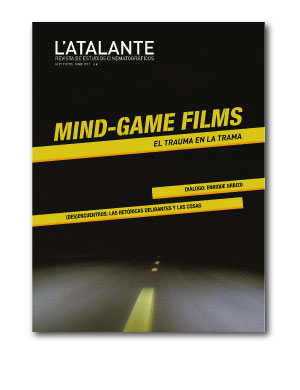Published 2013-01-01
Keywords
- Julio Medem,
- cinema,
- circles,
- narrative structure,
- composition
How to Cite
Roger Monzó, V. (2013). Medem’s circles. L’Atalante. Journal of Film Studies, (15), 93–98. https://doi.org/10.63700/47
Abstract
This article analyses the constant presence of circular structures in Julio Medem’s films and sheds light on the obsessive use of these spherical constructions by the Basque filmmaker. In order to do this, we have chosen the first five films of his body of work: Vacas (1992), La ardilla roja (1993), Tierra (1995), Los amantes del Círculo Polar (1999) and Lucía y el sexo (2002). The narrative analysis has been the methodology used to reach our aim. From this perspective, we have studied the organizational arrangements of the above listed filmic texts, classifying Medem’s circumferences in two types: the structural circles and the compositional circles. Moreover, we have considered the concept of circularity. In this way, we have been able to disassociate the artistic text from the pulse of human essence. As a consequence of our findings we have introduced another type of structures that we have named psycho-emotional circles.Downloads
Download data is not yet available.
References
ANGULO, Jesús, y REBORDINOS, José Luis (2005). Contra la certeza: el cine de Julio Medem. San Sebastián: Filmoteca Vasca - Euskadiko Filmategia.
CASETTI, Franchesco, y CHIO, Federico di (1991). Cómo analizar un film. Barcelona: Paidós.
FREUD, Sigmund (2002). Introducción al psicoanálisis. Madrid: Alianza Editorial.
COSTA, Antonio (1998). Saber ver el cine. Barcelona: Paidós.
GONZALEZ REQUENA, Jesús (1997). Emergencia de lo siniestro. Trama y Fondo, Lectura y Teoría del Texto, 2, 51-77.
HEREDERO, Carlos F. (1997). Espejo de miradas: entrevistas con nuevos directores del cine español de los años noventa. Madrid: Fundación Colegio del Rey, Festival de Cine de Alcalá de Henares, Ayuntamiento de Alcalá de Henares.
— (1999). 20 nuevos directores del cine español. Madrid: Alianza Editorial.
MAS, Salvador (ed.) (2000). Poética (de Aristóteles). Madrid: Biblioteca Nueva.
SALES ORTIZ, Eva (2003). El cine de Julio Medem: los ecos conmovidos de la imagen fílmica. Tesis Doctoral. Valencia: Universitat Politècnica de València.
SILES OJEDA, Begoña (2010). Arrebato: Un éxtasis siniestro. Razón y Palabra, 71, 1-16.
CASETTI, Franchesco, y CHIO, Federico di (1991). Cómo analizar un film. Barcelona: Paidós.
FREUD, Sigmund (2002). Introducción al psicoanálisis. Madrid: Alianza Editorial.
COSTA, Antonio (1998). Saber ver el cine. Barcelona: Paidós.
GONZALEZ REQUENA, Jesús (1997). Emergencia de lo siniestro. Trama y Fondo, Lectura y Teoría del Texto, 2, 51-77.
HEREDERO, Carlos F. (1997). Espejo de miradas: entrevistas con nuevos directores del cine español de los años noventa. Madrid: Fundación Colegio del Rey, Festival de Cine de Alcalá de Henares, Ayuntamiento de Alcalá de Henares.
— (1999). 20 nuevos directores del cine español. Madrid: Alianza Editorial.
MAS, Salvador (ed.) (2000). Poética (de Aristóteles). Madrid: Biblioteca Nueva.
SALES ORTIZ, Eva (2003). El cine de Julio Medem: los ecos conmovidos de la imagen fílmica. Tesis Doctoral. Valencia: Universitat Politècnica de València.
SILES OJEDA, Begoña (2010). Arrebato: Un éxtasis siniestro. Razón y Palabra, 71, 1-16.

